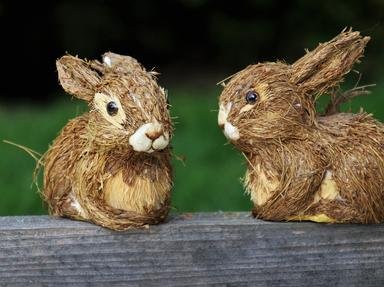Quiz Answer Key and Fun Facts
1. According to the words of the folk song, for what purpose did the bear go over the mountain?
2. In the Uncle Remus stories collected by Joel Chandler Harris in 1881, who is the bear often partnered with the fox?
3. Most of the Muppets have theatrical skills and aspirations. What does Fozzie Bear wish to become?
4. In Rudyard Kipling's "The Jungle Book" (1894) and in the Disney movie made from it (1967), there is a bear named Baloo who is in charge of instructing the cubs in the Seeonee wolf pack as well as Mowgli, the man cub. Where did he get his name?
5. Which American brewing company advertised its product using an Indian tom-tom beat, a cartoon bear and the phrase "from the land of sky-blue waters"?
6. Which English author, who created Monsieur Pamplemousse and his faithful canine companion Pommes Frits, also created Paddington Bear?
7. Which popular children's song served as the theme song for American radio's "Big Jon and Sparkie" and "No School Today" in the 1950s?
8. In which of William Shakespeare's plays does the stage instruction "Exit, Pursued by a Bear" appear?
9. What name fills in the blank in this public-service campaign jingle? "He can find a fire before it starts to flame. That's why they call him _________, that was how he got this name."
10. Which of John Irving's novels begins "The summer my father bought the bear, none of us was born - we weren't even conceived: not Frank, the oldest; not Franny, the loudest; not me, the next; and not the youngest of us, Lilly and Egg"?
11. Which group of bears, each with a belly badge to express its personality, began as a greeting-card series but grew to include motion pictures, television specials and series, and stuffed plush animals?
12. Who originally created the Berenstain Bears series of illustrated children's books?
13. In the King Fu Panda franchise, who is the chosen Dragon Warrior and the protagonist of the stories?
14. Which bear sang (or hummed) "The more it snows, tiddely-pom, the more it goes, tiddely-pom. The more it goes, tiddely-pom, on snowing. And nobody knows, tiddely-pom, how cold my toes, tiddely-pom, how cold my toes, tiddely-pom, are growing"?
15. In the Hanna-Barbera animated series, Yogi Bear is accompanied by which faithful ursine companion?
Source: Author
FatherSteve
This quiz was reviewed by FunTrivia editor
agony before going online.
Any errors found in FunTrivia content are routinely corrected through our feedback system.
